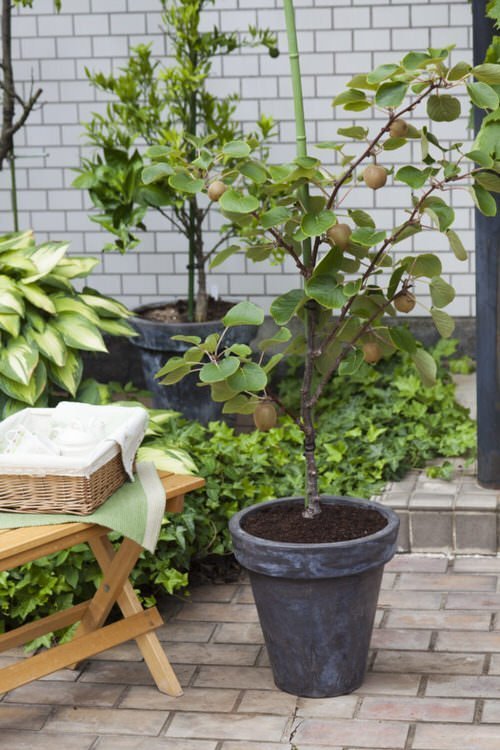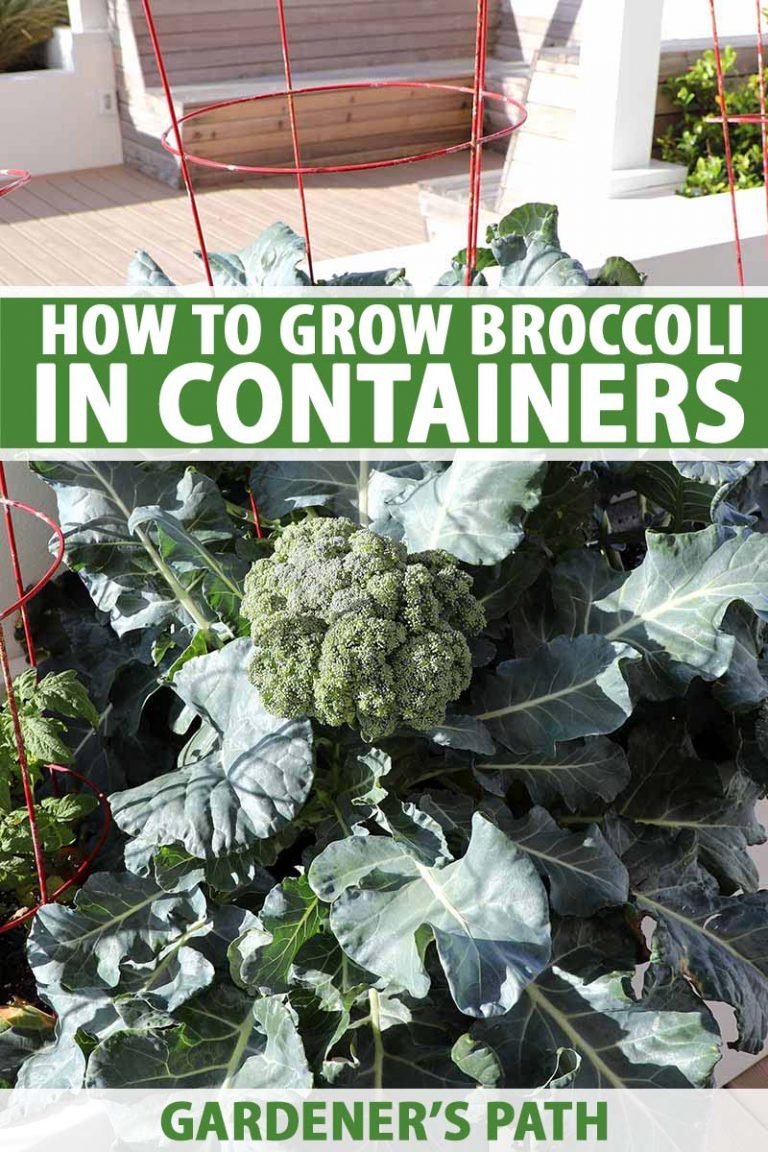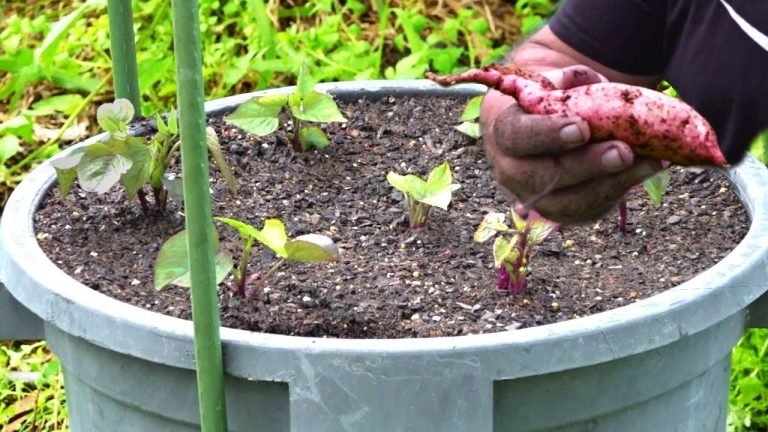how to grow kiwi in a pot – [Beginners Guide]
Do you love the idea of growing your own fruit but don’t have a lot of space to work with? Or maybe you’re just looking for a new and exciting gardening project to take on? Either way, growing kiwi in a pot may be the perfect solution for you!
I first discovered the joys of growing kiwi in a pot several years ago and have been hooked ever since. Not only is it a fun and rewarding experience, but it’s also a great way to have fresh kiwi on hand whenever you want it.
Growing kiwi in a pot has many benefits, including the fact that it allows you to have control over the growing conditions. This means you can create the perfect environment for your kiwi plant, ensuring it gets the right amount of sunlight, water, and nutrients.
Another advantage of growing kiwi in a pot is that it’s a space-efficient option. Even if you don’t have a large backyard, you can still enjoy the benefits of fresh kiwi by growing it in a pot on your balcony, patio, or windowsill.
In this guide, we’ll walk you through the steps of growing kiwi in a pot, from choosing the right container and soil to caring for your plant throughout its growth cycle. We’ll also discuss some common problems you may encounter and how to troubleshoot them.
So, if you’re ready to add a new and exciting gardening project to your repertoire, let’s dive in and learn how to grow kiwi in a pot!
Pot or container selection
When it comes to growing kiwi in a pot, choosing the right container is just as important. Kiwi plants have deep and extensive roots, so you’ll need a pot that is large enough to accommodate them and provide enough space for growth.
For optimal growth, you should choose a pot that is at least 20 inches (50 cm) in diameter and 20 inches (50 cm) deep. This will give your kiwi plant plenty of room to spread out its roots and establish a strong foundation. Keep in mind that the larger the pot, the more soil it will hold, which means better water retention and fewer chances of the plant drying out.
When it comes to pot construction, there are a few things to consider as well. Firstly, the material of the pot should be sturdy and durable. Terracotta and ceramic pots are popular choices, as they are porous and allow for proper drainage. Plastic pots are also a good option as they are lightweight and easy to move around.
Secondly, your pot should have good drainage to prevent waterlogging, which can cause root rot. Make sure your pot has drainage holes in the bottom, and consider adding a layer of rocks or gravel to promote drainage.
Lastly, consider the shape of your pot. Kiwi vines are climbing plants, so a taller pot with a trellis or support system is ideal. This will allow the plant to climb and grow upwards, saving valuable space in your garden.
In conclusion, choosing the right pot for growing kiwi is essential to the success of your plant. By selecting a large and sturdy container with good drainage and a supportive shape, you’ll give your kiwi the best chance to thrive and produce a bountiful harvest.
Make suitable soil mix
To grow kiwi at home, you will need a soil mix that is well-draining, nutrient-rich, and slightly acidic. Here’s what you need to know about the type and mixture of soil required for growing kiwi:
Type
For growing kiwi, it’s best to use a high-quality potting mix specifically formulated for fruit trees. These mixes are usually made from a combination of peat moss, perlite, vermiculite, and compost, and are designed to provide the right balance of nutrients and drainage for your plants.
Avoid using garden soil or topsoil, as these types of soil may not have the right composition for container-grown plants. They may also contain weed seeds or pathogens that can harm your kiwi plants.
Mixture
In addition to using a high-quality potting mix, you may also want to consider adding some amendments to your soil to give your kiwi plants a boost. Some options include:
- Compost: Adding compost to your soil can help improve its structure, drainage, and nutrient content.
- Organic fertilizers: You can use organic fertilizers, such as bone meal or blood meal, to provide additional nutrients for your plants.
- pH adjusters: Kiwi plants prefer a slightly acidic soil pH (between 5.0 and 6.5). You can use sulfur or aluminum sulfate to lower the pH of your soil, or lime to raise it.
It’s important to note that kiwi plants are sensitive to waterlogged soil, so make sure your soil mix is well-draining. Also, make sure your container has sufficient drainage holes to prevent water from accumulating at the bottom.
In summary, the correct soil composition is essential for optimal growth of kiwi plants. A well-draining, nutrient-rich, and slightly acidic soil mix will provide the right conditions for your plants to thrive. Adding compost, organic fertilizers, and pH adjusters can give your kiwi plants an extra boost.
How to plant the kiwi?
Here’s a step-by-step guide for planting kiwi in a pot at home:
Step 1: Choose the right pot
Select a pot that is large enough to accommodate the root system of your kiwi plant. A pot with a diameter of at least 16 inches and a depth of at least 18 inches is a good size for most kiwi varieties. Make sure the pot has drainage holes to allow excess water to drain away from the roots.
Step 2: Prepare the soil mix
Fill the pot with a well-draining, nutrient-rich potting mix. You can make your own mix by combining equal parts of peat moss, perlite, and compost or you can buy a pre-made mix formulated for fruit trees.
Step 3: Plant the kiwi seedling
Remove the kiwi seedling from its container, taking care to gently loosen the roots. Place the seedling in the center of the pot, making sure that the root ball is level with the soil surface.
Fill in around the root ball with soil, gently tamping it down to remove any air pockets. Water the seedling well to help settle the soil around the roots.
Step 4: Support the plant
Kiwi vines can grow up to 20 feet long, so they will need a trellis or support system to grow properly. Place a trellis or stake in the pot before or immediately after planting the kiwi seedling. You can also use a tomato cage to support the plant.
Step 5: Water and fertilize
Keep the soil moist, but not too wet. Water deeply once or twice a week, depending on the weather and the size of the pot. Allow the soil to dry out slightly between waterings to prevent overwatering, which can lead to root rot.
Fertilize the kiwi plant with a balanced fertilizer once a month during the growing season. You can use a slow-release fertilizer or a liquid fertilizer mixed with water according to the package instructions.
Step 6: Prune the plant
Prune the kiwi plant regularly to control its growth and shape it. Remove any dead or damaged wood and prune back the side shoots to encourage the plant to grow taller. In the winter, prune the plant back to promote fruiting the following year.
With proper care and attention, your kiwi plant will produce sweet and juicy fruit that you can enjoy right at home.
How to care for kiwi?
Growing kiwi in a pot at home can be a rewarding experience, and with proper care, you can enjoy a bountiful harvest of this delicious fruit. Here’s what you need to know about caring for kiwi plants in a pot:
Watering Requirement
Kiwi plants need consistent moisture to grow and produce fruit. Water your kiwi plant deeply once or twice a week, depending on the weather and soil conditions. Check the soil moisture level by sticking your finger about an inch into the soil. If it feels dry at that depth, it’s time to water. Kiwi plants are sensitive to overwatering, so make sure the pot has good drainage to avoid waterlogged soil.
Fertilizer Requirement
Kiwi plants are heavy feeders and require regular fertilization to produce fruit. Use a balanced fertilizer, such as a 10-10-10 formula, according to the package directions. Alternatively, you can use a slow-release fertilizer or compost to provide a steady supply of nutrients over time. Apply fertilizer every 4-6 weeks during the growing season, starting in the spring and ending in late summer.
Sunlight Needs
Kiwi plants need plenty of sunlight to thrive, so choose a spot in your garden or patio that gets at least 6 hours of direct sunlight per day. If you don’t have a sunny spot outdoors, you can also grow kiwi in a sunny window indoors using a grow light.
Pruning & Training
Pruning and training kiwi plants can help improve air circulation, increase sun exposure, and make harvesting easier. Kiwi plants can become quite large, so it’s important to prune them regularly to control their size and shape. Prune your kiwi plant in late winter or early spring before new growth begins. Remove any dead, damaged, or diseased wood, as well as any shoots that are growing in the wrong direction. Use a trellis or wire support to train the main stem of your kiwi plant to grow vertically, and tie it to the support as it grows.
Other Care
In addition to watering, fertilizing, and pruning, there are a few other things you can do to care for your kiwi plant:
- Mulch the soil around the plant to help retain moisture and suppress weeds.
- Protect your kiwi plant from extreme temperatures and frost by covering it with a blanket or tarp.
- Be on the lookout for pests and diseases. Common problems include scale insects, spider mites, and powdery mildew. If you notice any issues, take action immediately to prevent them from spreading.
- Harvest your kiwi fruit when it’s fully ripe but still firm to the touch. Kiwi fruit will continue to ripen off the vine, so it’s best to harvest them a little early and let them ripen indoors.
With these tips in mind, you can successfully grow kiwi in a pot at home and enjoy the fruits of your labor.
Common problems
Other Issues
In addition to the common problems mentioned above, there are some other issues that kiwi grown in pots may face:
- Root-bound plants: If the kiwi plant has been in the pot for too long, the roots may become bound and compacted. This can limit the plant’s growth and reduce its productivity. To prevent this, you can periodically repot the plant into a larger pot or prune the roots.
- Drying out: Kiwi plants require regular watering to thrive, and if the potting mix dries out completely, it can cause the leaves to wilt and the plant to suffer. To prevent this, make sure to water the plant regularly and use a potting mix that retains moisture.
- Nutrient deficiencies: Kiwi plants require a variety of nutrients to grow and produce fruit, and if they are not provided with enough of these nutrients, they may suffer from deficiencies. To prevent this, fertilize the plant regularly with a balanced fertilizer that contains nitrogen, phosphorus, and potassium.
- Temperature fluctuations: Kiwi plants can be sensitive to temperature fluctuations, especially if they are grown in an area that experiences hot, dry summers or cold, frosty winters. To prevent this, provide the plant with a stable environment that is protected from extreme temperatures.
By monitoring your kiwi plant regularly and addressing any issues that arise promptly, you can help ensure that it grows and produces fruit optimally.
Harvesting & storing homegrown kiwi
When it comes to harvesting and storing homegrown kiwi, there are a few things to keep in mind. Kiwis are typically ready to harvest in late autumn or early winter, depending on the climate and growing conditions. To know when they are ready for harvesting, look for the following signs:
Check the skin of the kiwi: when the skin starts to turn slightly brown and becomes fuzzy, this is a sign that the kiwi is ripe.
Give the kiwi a gentle squeeze: if the kiwi yields to gentle pressure, it’s ready to harvest. If it’s too soft or mushy, it may be overripe.
When harvesting kiwis, it’s best to cut them from the vine using a pair of sharp scissors or pruning shears. Be careful not to damage the fruit or the vines. Once harvested, kiwis can be stored for several weeks or even months, depending on the variety and storage conditions. Here are a few tips for storing kiwis:
Store kiwis in a cool, dry place with good ventilation, away from direct sunlight and heat sources.
Do not store kiwis with other fruits, as kiwis produce ethylene gas which can cause other fruits to ripen too quickly.
If you need to ripen kiwis quickly, place them in a paper bag with an apple or banana. These fruits produce ethylene gas which can speed up the ripening process.
You can also freeze kiwis for later use. Simply peel and slice the kiwis, then place them in an airtight container or resealable bag and freeze them for up to 6 months.
By following these tips, you can ensure that your homegrown kiwis stay fresh and delicious for as long as possible.
Growing kiwi in container – Conclusion
Congratulations on learning how to grow kiwi in a pot! Growing your own kiwi fruit can be a wonderful way to enjoy fresh, delicious produce right from your own home. With the right information and care, anyone can successfully grow kiwi in a pot, regardless of their gardening experience or space constraints.
Remember to choose the right pot and soil mix, provide the plant with adequate sunlight and water, and monitor for common problems such as pests, insects, diseases, and poor production. By following these steps and keeping a watchful eye on your plant, you can look forward to a bountiful harvest of juicy kiwi fruit.
So why not give it a try? With a little bit of patience and effort, you can enjoy the satisfaction of growing your own kiwi at home. So grab a pot, some soil, and start planting! Happy gardening!






